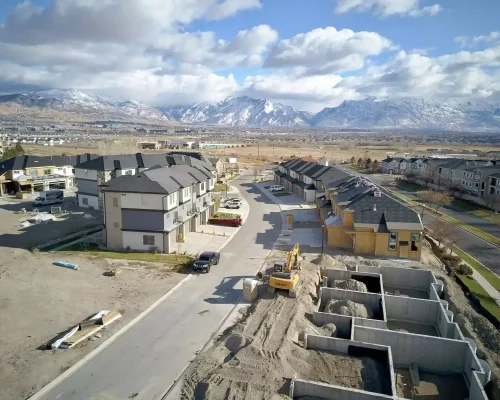Civil, Structural, Environmental, and Land Surveying
Move to Construction Quickly with Trusted Engineering
At Anderson Engineering, our team handles every aspect of engineering, surveying, and permitting—helping you overcome delays, ensure compliance, and build with confidence.
Custom Solutions Delivered to Meet Your Unique Project Requirements
Top-Quality Engineering and Construction Drawings
Expert Problem Solvers with Decades of Experience
Customized Engineering and Surveying Solutions for Every Phase of Your Project
With over 5,000 completed projects across civil, structural, environmental engineering, and land surveying, Anderson Engineering streamlines the design and permitting process to keep your project moving. Our team navigates complex regulations, mitigates risks, and ensures compliance—so you can break ground without costly delays or surprises.
Bespoke Engineering
Turn-key Solutions
Streamline Permitting and Engineering to Keep Your Project Moving and Break Ground Faster
Eliminate Delays
We streamline engineering and permitting to keep your project on schedule, avoiding setbacks.
Precision Compliance
With expertise spanning 65 engineering sub-disciplines, we streamline compliance to keep projects on track - serving homeowners, small businesses, and large corporations with efficiency and confidence.
Comprehensive Approach
We manage all regulatory and permitting aspects, letting you break ground with confidence—whether you are a homeowner, small business, or large corporation.
Stress-Free Progress
Our proactive support removes confusion, providing a clear path to construction and ensuring a smooth process for all clients.
Realize Your Project Vision with Expert Engineering
Get the Extra Care and Expertise
Your Project Deserves with Us.
Partner with Anderson Engineering for your large-scale civil design and infrastructure needs. We navigate complex regulations, ensure compliance, and mitigate risks to keep your high-value projects moving smoothly.
Expert Oversight
Principal-led engineering ensures precision, minimizing delays and issues. This benefits small business owners by reducing unexpected costs, supports homeowners with dedicated attention, and helps large corporations keep projects on track.
Tailored Solutions
Customized designs ensure seamless permitting and regulatory approval, minimizing costs. High-income homeowners receive tailored, high-quality solutions, while businesses get reliable, efficient designs that fit their needs.
Agile Communications
Fast updates keep you informed, enabling quick decisions and avoiding setbacks. Small business owners can rely on agile responses, homeowners benefit from clear communication, and large corporations experience reduced risks from miscommunication.
Commitment to Safety
Certified in HAZWOPER, MSHA, and OSHA, we maintain a recordable-incident-free track record for over 20 years. Homeowners gain peace of mind, small businesses reduce liability, and corporations achieve compliance effortlessly.
State-of-the-Art Methods and Equipment
We use advanced LiDAR, 3D modeling, and drone mapping to deliver precise designs—reducing errors, ensuring compliance, and optimizing costs for businesses and homeowners.
Responsive Service
With a 95% client retention rate, we resolve issues quickly to keep projects on track. Small business owners avoid unnecessary setbacks, homeowners see prompt responses, and corporations get dependable progress.
Guiding Your Project Every Step of the Way
When facing design, permitting, or regulatory challenges, we help resolve these obstacles with civil, structural, environmental, and land surveying services to keep your project moving forward. At Anderson Engineering, our process—Right Tools, Right Methods, Right People (R3TMP)—is tailored to meet your exact requirements.
The R3TMP Process ensures your project stays on course—from concept through to construction—with minimal delays and expert guidance every step of the way.
Move your project forward with confidence—schedule your consultation today!
Our Clients' Success Stories
Discover why 95% of keep coming back for expert solutions and reliable results.

“I have worked with Anderson Engineering on various projects. Their expertise in civil engineering, environmental consulting, and land surveying has been crucial for our success. Their responsive service and dedication to long-term partnerships make them a dependable partner.”
David Anderson
Harvest Village

“No one took my project seriously until Anderson Engineering got involved. They resolved my property line issue, created a beautiful water-wise landscape plan, and even helped get it approved by the HOA. Whenever I needed more help, they were always available. Their professionalism and dedication made all the difference—I finally felt supported. I highly recommend Anderson Engineering.”
Carol Beck
Homeowner - Saratoga Springs, UT

“At R-Squared, we sought opportunities in the raw land real estate markets, and I worked with Anderson Engineering on due diligence for land development across the western U.S. Anderson Engineering is a creative, detail-oriented, and action-driven partner. They effortlessly shift from big-picture strategy to technical details and hands-on work. Their ability to quickly assess engineering, development options, and project economics is unmatched.
David Christensen
Land Developer
Your Path to a Successful Build: Expert Engineering, Environmental, and Surveying Solutions
Explore what makes Anderson unique to efficiently move your project from planning to construction with precision. That will move your project from planning to construction with precision and efficiency.
Principal-Led Projects
Our Principals lead each project with expert oversight, ensuring precision while minimizing delays and issues.
Tailored Solutions
We provide customized designs that meet the unique needs of each project, ensuring smooth and efficient progress toward construction.
Certified Safety Practices
Certified in HAZWOPER, MSHA, and OSHA, we have ensured a recordable-incident-free environment for over 24+ years, maintaining the highest standards of safety.
Responsive Communications
We provide quick and clear updates to keep you informed, enabling faster decision-making and ensuring your project stays on track.
Multidisciplinary Expertise
Our in-house integration of civil, structural, environmental engineering, and land surveying - combined with adancced modeling, GIS mapping, and permitting expertise - optimnizes project workflows, reducing delays and accelerating deliverables.
Regulatory Compliance Expertise
We expertly navigate the complex regulations specific to Utah and the Intermountain West to ensure your project remains compliant and on schedule.
Big-Small Company Approach
We are a big-small company with decades of experience and the expertise of much larger firms.
Local and Regional Knowledge
With strong local insights and relationships, we secure permits faster, moving projects from planning to construction with minimal delays.
State-of-the-Art Technology
We utilize advanced tools like LiDAR, 3D modeling, and drone surveys to ensure precision and efficiency, aligning your project closely with your vision.
Decades of Experience
With over 5,000 projects completed, our extensive experience has consistently reduced risks, contributing to a 95% client satisfaction rate.
Balanced Resource Allocation
We maintain efficient resource management to keep your project well-supported and within budget.
Accurate Data Collection
Our precise data collection methods have minimized costly mistakes, reducing field data collection, management, and reporting costs by 40%.
Ready to take the next step? Let's get your project moving.
Comprehensive Civil, Structural, Environmental, and Surveying Solutions for Any Project Scale.
Long-Lasting Purposeful Relationships
Anderson Engineering delivers exceptional results across civil, structural, and environmental engineering throughout Utah and the Intermountain West. Our expertise ensures that your project progresses seamlessly from conception to completion, minimizing risks and maximizing quality.
With a tailored approach, we provide the best value and service for infrastructure design, structural integrity, environmental compliance, and land surveying specific to the unique needs of our local communities. Partner with Anderson Engineering today to transform your vision into reality—contact us to discuss your project needs in Utah and beyond.
